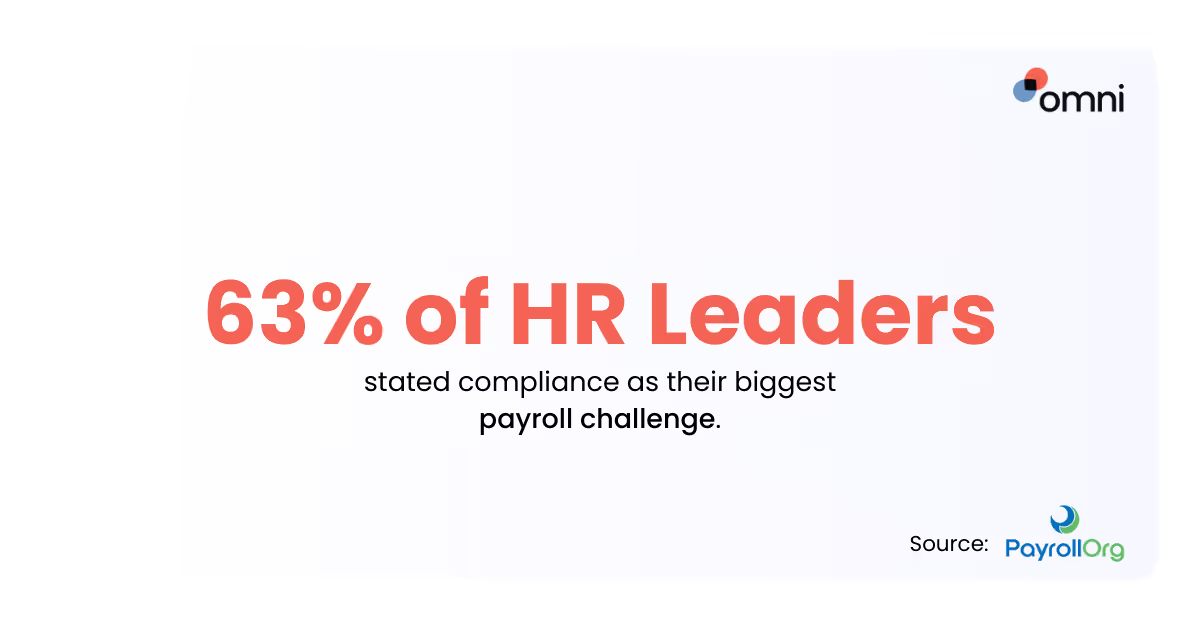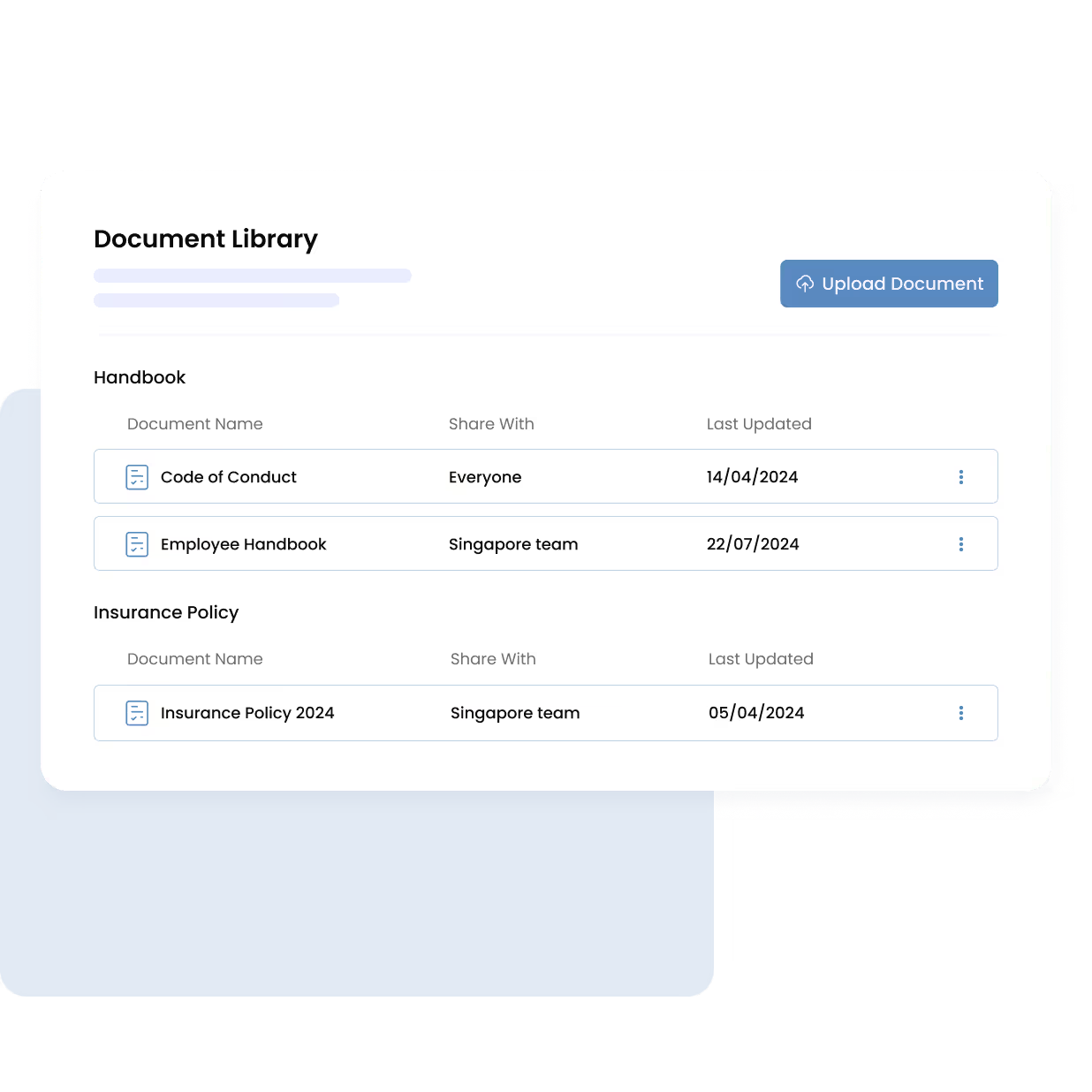Summary. HR regulatory compliance remains a significant challenge for 63% of HR leaders. In Singapore, HR teams must navigate multiple employment laws, including the Employment Act, Workplace Safety and Health Act, Central Provident Fund Act, Personal Data Protection Act, and Child Development Co-Savings Act. Common compliance issues include improper termination handling, working hours violations, inadequate record-keeping, late CPF contributions, insufficient safety training, data security failures, and discriminatory practices. To mitigate these risks, organizations should implement essential HR policies and templates, including employment contracts specifying job details and compensation, comprehensive employee handbooks outlining company culture and expectations, leave management policies, disciplinary procedures, performance management frameworks, data protection guidelines, anti-discrimination policies, and whistleblowing protocols. Effective compliance management not only prevents costly penalties and legal action but also protects employee rights, supports international expansion, and enhances employer branding.
The 2024 Getting the World Paid survey revealed that 63% of HR leaders stated compliance as their biggest payroll challenge. This data isn’t surprising, as complex employment laws complicate human resource management, especially when hiring globally. HR teams must constantly stay updated on various regulations covering employment standards, workplace safety, payroll practices, taxation, and data privacy.

Let's face it—monitoring HR regulatory compliance while handling administrative tasks like recruiting, onboarding, paying salaries early, and employee queries can be overwhelming. Even minor errors can lead to legal action from aggrieved workers or financial losses from penalties.
That’s why we’ve created a checklist that provides a structured reminder of all the necessary steps for HR regulatory compliance. This article explores the most common HR regulatory compliance issues and demonstrates how managers can mitigate the risks through an HR compliance checklist with workable templates.
Get your free Singapore compliance checklist today!
What is compliance management in HR?
HR regulatory compliance involves adhering to relevant labor laws and industry practices guiding all employment matters, from hiring to termination. Its goal is to prevent legal violations that can lead to costly fines, penalties, lawsuits, and reputational damage.
HR teams must manage and enforce legal requirements, policies, and procedures to protect their organization from non-compliance risks and create a fair work environment.
Why is it important?
HR regulatory compliance management benefits businesses in several ways. It protects employee rights and ensures fair workplace practices, free from wage disparities, hazardous working conditions, and discrimination. It also prevents hefty fines, operational disruptions, regulatory audits, and legal action arising from infractions. Ultimately, it enables organizations to operate efficiently without increasing overhead costs.
Furthermore, adhering to these practices ensures smooth international expansion, as companies with an HR regulatory compliance record can quickly adapt to labor law changes. It also promotes positive employer branding among regulatory bodies, potential employees, and local markets.
What are the important employment laws in Singapore?
Singapore has various regulations protecting employee rights, information management, and other vital employment issues. Below, we explore critical HR laws Singapore companies must adhere to:
Employment Act
The Employment Act is Singapore’s main labor law. It covers the basic terms and working conditions for all employees, including part-time, contract, and temporary staff. While it applies to both locals and foreigners working in Singapore, some sections, like work hours and rest days, don’t apply to managers and executives.
The Act provides basic protection for employees, regulating working hours, overtime pay, rest days, annual leave, and termination procedures. HR professionals in Singapore must understand the Employment Act and stay up-to-date with changes to avoid applying outdated practices.
Workplace Safety and Health Act
The Workplace Safety and Health Act (WSH) regulates the safety, health, and welfare of employees in the workplace. It includes all workplace environments, employers’ responsibilities, hazardous substances, machinery, and equipment. Additionally, the WSH Act requires employers to provide a safe workplace, focusing on health systems and outcomes rather than only compliance.
Central Provident Fund Act
The Central Provident Fund (CPF) is a mandatory social security savings scheme funded by contributions from employers and employees to meet retirement, housing, and healthcare needs. Under the Act, CPF members under 55 earn up to 5% interest on the first $60,000 of their total CPF savings. Those 55 and older earn up to 6% interest on the first $30,000 and up to 5% on the next $30,000.
By contributing to CPF, employers fulfill their statutory obligations and provide financial security to employees, fostering a positive and compliant company culture. Below are the contribution rates HR managers must adhere to for compliance:
Personal Data Protection Act
The PDPA governs the collection, use, disclosure, and care of personal data in Singapore. By regulating the flow of personal data among companies, the PDPA aims to strengthen Singapore’s position as a trustworthy location for businesses. You must comply with this Act to protect employees’ data from misuse and maintain their trust in your organization.
Learn more: How HRIS Supports Employee Data Management
Child Development Co-Savings Act
The CDCA aims to encourage married couples in Singapore to have more children. It provides benefits such as paid maternity, paternity, or childcare leave, ensuring eligible parents receive financial assistance to care for their children while remaining employed.
Other relevant legislation
Other relevant HR law Singapore includes:
- Retirement and Re-employment Act
- Protection from Harassment Act
- Industrial Relations Act
- Trade Unions Act
- Trade Disputes Act
What are the most common HR regulatory compliance issues?
HR departments often experience these HR regulatory compliance issues:
- Improper handling of termination: Laying off employees without proper notice or paying final wages as specified in their employment contract can attract penalties or lawsuits.
- Non-compliance with working hours and overtime regulations: Failing to comply with specified working hours, minimum wage laws, or overtime pay can lead to fines and disputes.
- Inadequate record-keeping: Keeping inaccurate employee records, such as date of employment, salary, contact details, and working hours, can cause HR regulatory compliance issues during audits.
- Late or inaccurate CPF contributions: HR teams often struggle with deducting correct rates and submitting them early to the CPF board.
- Inadequate safety training: Employers must provide workplace safety training to help employees use equipment correctly, identify hazards, and follow emergency procedures.
- Failing to implement appropriate data security measures: Mishandling employee data violates the PDPA and can result in fraud, fines, and loss of trust.
- Discriminatory hiring practices: Engaging in biased hiring, gender pay gaps, or any discriminatory practice that violates diversity, equity, and inclusion (DEI) can result in legal penalties, reputational damage, and the loss of diverse talent.
What are the essential HR policies and templates?
To ensure HR regulatory compliance and a positive work environment, organizations should have clear HR policies and templates, including:
Employment contract templates
An employment contract specifies the rights and obligations of the employer and employee. It includes key terms such as:
- Job title and description
- Employment start date
- Working hours, work days per week, and rest days
- Salary, overtime pay, bonuses, and other compensation packages.
- Employment duration for temporary contracts
- Allowances and deductions
- Probationary period
- Paid time off and other benefits
- Notice periods for termination of employment
Read next: How to Define Your Employee's Job Scope (With a Template!)
Employee handbook template
This document outlines your company’s culture, policies, expectations, and guidelines while ensuring HR regulatory compliance. It serves as a reference guide to help employees understand their rights and responsibilities to the organization. It typically includes:
- Company mission, vision, and values
- Code of conduct and workplace ethics
- Health and safety guidelines
- Salary structure and benefits
- Performance review processes
- Training and professional development opportunities
- Data privacy and confidentiality guidelines
- Disciplinary procedures
- Resignation and notice period requirements
Download our free employee handbook template now!
Leave management policy
This policy outlines employee time-off entitlements, specifying the number of days for different types of leave. It covers various leave categories, including sick, annual, parental, and statutory holidays.
Disciplinary and grievance procedures
This document details how your organization addresses employee misconduct, performance issues, and workplace disputes according to HR law Singapore. It specifies the types of misconduct, investigation processes, disciplinary measures, and steps to report grievances.
Performance management policy
This document outlines how your company evaluates and improves employee performance. It includes review objectives, key performance indicators (KPIs), performance goals, appraisal processes and frequency, Performance Improvement Plans (PIP), feedback, and reward systems.
Free resources: Performance Improvement Plan (PIP) Template
Data protection policy
This document specifies how your organization collects, shares, and processes sensitive employee data and customer information. It also outlines the measures for protecting this information to comply with Singapore’s data privacy laws. It includes the types of data, collection processes, security measures, and rules for handling data to prevent breaches.
Additional reading: Intro to HR Analytics and Leveraging HR Data
Anti-discrimination and harassment policy
This policy ensures fair treatment, promotes inclusivity, and protects employees from gender, racial, disability, or religious discrimination and harassment. It specifies discriminatory acts, steps for reporting violations, investigation, and disciplinary actions.
Whistleblowing policy
This document encourages employees to report unethical, improper, or illegal behavior within the organization while protecting them from retaliation. It details types of misconduct (fraud, harassment, or safety violations), procedures for reporting (via email or third-party platforms), anonymity, and protection against dismissal or demotion.
Creating an HR Compliance Checklist (with a Template!)
Follow this HR compliance checklist (SHRM) for seamless HR regulatory compliance:
- Ensure your processes adhere to vital laws such as the Employment Act, CPF Act, WSH Act, PDPA, and Tripartite guidelines.
- Provide clear employment contracts outlining roles, salary, and benefits.
- Define working hours, overtime, leave entitlements, notice periods, and rest days.
- Register employees for CPF contributions.
- Calculate, pay on time, and keep accurate records of contributions.
- Implement workplace safety policies.
- Conduct regular risk assessments and safety training.
- Secure sensitive data from unauthorized access to align with PDPA’s HR regulatory compliance requirements.
- Ensure final salary payments and conduct exit interviews.
- Maintain accurate employee records, including contracts, payroll, leave, and termination documents.
- Stay up-to-date with new laws or regulatory amendments.
Get your free Singapore Compliance Toolkit here!
Stay Compliant in Singapore with Omni
While adhering to HR regulatory compliance is crucial for avoiding legal issues, it is even more fulfilling to prioritize compliance for the well-being of your employees. Make it your goal to enhance their working conditions, leading to increased job satisfaction and employee engagement.
Adding purpose to tasks that may seem mundane or bureaucratic motivates you to strive for excellence, achieving better HR compliance in the process. We understand that this might seem like additional effort, but a reliable HR software solution takes on the bulk of the workload, allowing you to focus on advancing your mission.

With Omni, you gain access to data-driven insights that empower informed decision-making, as well as seamless integrations that effortlessly connect with your existing employee-favored systems, making your entire engagement process more efficient and modern.
Omni scales alongside your team so you can customize and leverage the system to meet your business exactly where you are—as well as where you’re going.
With a full suite of modules to support every aspect of your business, Omni’s platform offers an intuitive and fully customizable platform that integrates with your team’s favorite tools for a seamless and timely adoption.
"Omni has transformed our HR processes. With Omni, we’ve seen a 20% drop in attrition and a major boost in employee satisfaction and efficiency. It’s a user-friendly, time-saving solution that has revolutionized our HR department."
— Tengku Mohaizad, Group Head of HR Asia, Inspire Brands Asia
Read next: See how Inspire Brands Asia saved up to US$15,000 with Omni HR
If you’d like to learn more about how Omni’s all-in-one HR software automates the entire end-to-end employee lifecycle, saving People leaders from administrative tasks and increasing organizational innovation,
Full HR & Payroll coverage for Philippines, Singapore, Malaysia, Hong Kong, and Indonesia. Each market has local support teams and built-in compliance features.
Starting at $3/employee/month for core features. Volume-based discounts are available for growing teams. Book a demo for custom pricing.
Enterprise-grade security with ISO 27001, GDPR certifications, and local data residency options.
4 weeks average. Includes free data migration, setup, and team training. No hidden fees.
Built specifically for Asia with local payroll processing, same-day support in Asia time zones, and 40% lower cost than global alternatives.




.avif)
.avif)


